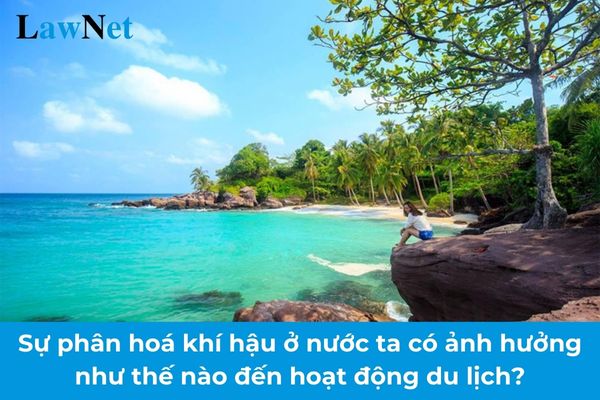How does the diversification of climate in Vietnam affect tourism activities? What are regulations on online teaching activities at the lower secondary education level in Vietnam?
How does the diversification of climate in Vietnam affect tourism activities?
The diversification of climate in Vietnam has a profound impact on tourism activities, affecting the formation of tourist destinations, types of tourism, tourist seasons, and the overall experience of tourists.
Tropical Monsoon Climate and Altitudinal Zoning:
In mountainous areas, climate diversification by altitude creates ideal conditions to develop various types of tourism such as leisure, sightseeing, and exploration. High mountainous regions with cool climates year-round, fresh air, and beautiful natural landscapes have become famous destinations. For instance, Sa Pa (Lao Cai) is known for its temperate climate and unique indigenous culture; Tam Dao (Vinh Phuc) and Ba Na (Da Nang) are known as ideal resorts, while Da Lat (Lam Dong) attracts tourists with its romantic atmosphere and pleasant climate throughout the year. These features contribute to the formation of unique tourism products linked with nature and climate.
Climate Diversification Between Northern and Southern Regions:
The stark difference in climate between the two regions has shaped the tourism seasons in each area. The North, with its four distinct seasons, particularly the hot summer, is a peak time for beach tourism activities in areas like Ha Long, Cat Ba, Sam Son, etc. In contrast, the South has a stable and warm climate all year, allowing beach tourism activities in places like Phu Quoc, Nha Trang, Vung Tau to take place regardless of the season. This difference helps Vietnam's tourism exploit a diverse range of destinations according to each season, meeting the demands of both domestic and international tourists.
Impact of Extreme Weather Phenomena:
Weather phenomena such as heavy rains, storms, floods, or thick fog are major obstacles to tourism activities, especially outdoor tourism types like beach bathing, mountain climbing, and sightseeing. For example, the stormy season in Central Vietnam often poses challenges for heritage tours in Hue, Hoi An, or island tours. Additionally, the dense fog phenomenon in high mountainous areas during winter can affect transportation and the safety of tourists.
Impact on Tourism Development Orientation:
Climate diversification not only creates a variety of destinations and types of tourism but also shapes the development strategies of the tourism industry in each region. Localities need to have plans to exploit tourism in accordance with climatic conditions and focus on sustainable tourism development, minimizing the negative impact of adverse weather. For example, in areas affected by storms and rains, building safe tourism infrastructure, organizing low-season tourism programs, or developing indoor tourism types are necessary directions.
In summary, climate diversification in Vietnam is both an advantage in developing a variety of tourism types and destinations and a challenge that needs effective management to ensure the sustainable development of the tourism industry.
Note: The content is for reference only.

How does the diversification of climate in Vietnam affect tourism activities? What are regulations on online teaching activities at the lower secondary education level in Vietnam? (Image from the Internet)
What are regulations on online teaching activities at the lower secondary education level in Vietnam?
Pursuant to Article 5 of Circular 09/2021/TT-BGDDT, regulations on online teaching activities at lower secondary education level are as follows:
- Online teaching activities are conducted according to lessons or topics in the general education curriculum, ensuring interaction between teachers and students during the teaching process.
- Students learning online engage in the following main activities: attending online classes organized by teachers; participating in learning and assessment activities as required by teachers; accessing learning content from online teaching materials; asking and answering questions with teachers and other students.
- Teachers conducting online teaching undertake the following main activities: organizing online classes to deliver lessons and guide students in learning; assigning learning tasks and assessing students' learning outcomes; supporting students in accessing learning content from online teaching materials; advising, supporting, answering questions, and resolving students' inquiries.
- The head of the general educational institution decides on the form of organizing online teaching to support direct teaching at the educational institution; organizing online teaching as a replacement for direct teaching at the educational institution when students cannot attend school for learning due to force majeure reasons.
Where can lower secondary school students in Vietnam have periodic evaluation of online learning results?
Pursuant to Clause 2, Article 6 of Circular 09/2021/TT-BGDDT, regulations on evaluation and assessment in online teaching are as follows:
Evaluation and Assessment in Online Teaching
...
- Periodic evaluation of online learning results of students is conducted directly at the general educational institution according to the periodic evaluation and assessment regulations of the Ministry of Education and Training.
In cases where students cannot attend the general educational institution at the time of periodic evaluation due to force majeure reasons, the periodic evaluation and assessment are conducted online; the head of the general educational institution decides on the format of periodic evaluation and assessment according to the Ministry of Education and Training's regulations, ensuring accuracy, fairness, objectivity, and truthfulness.
Thus, lower secondary school students are periodically evaluated for their online learning results at the general educational institution in accordance with the periodic evaluation regulations of the Ministry of Education and Training.
Additionally, in cases where students cannot attend the general educational institution for periodic evaluation due to force majeure reasons, online evaluation is conducted.

